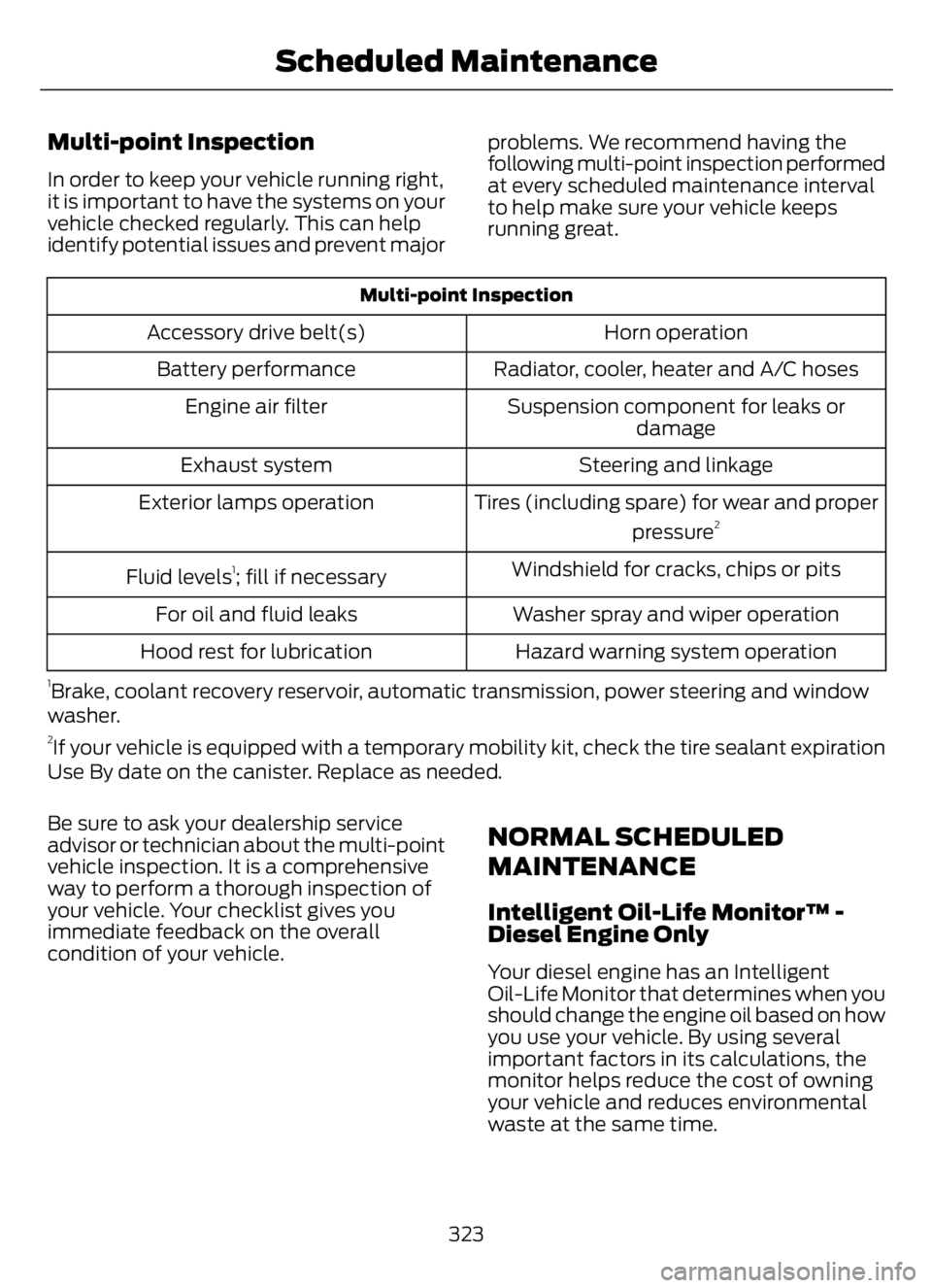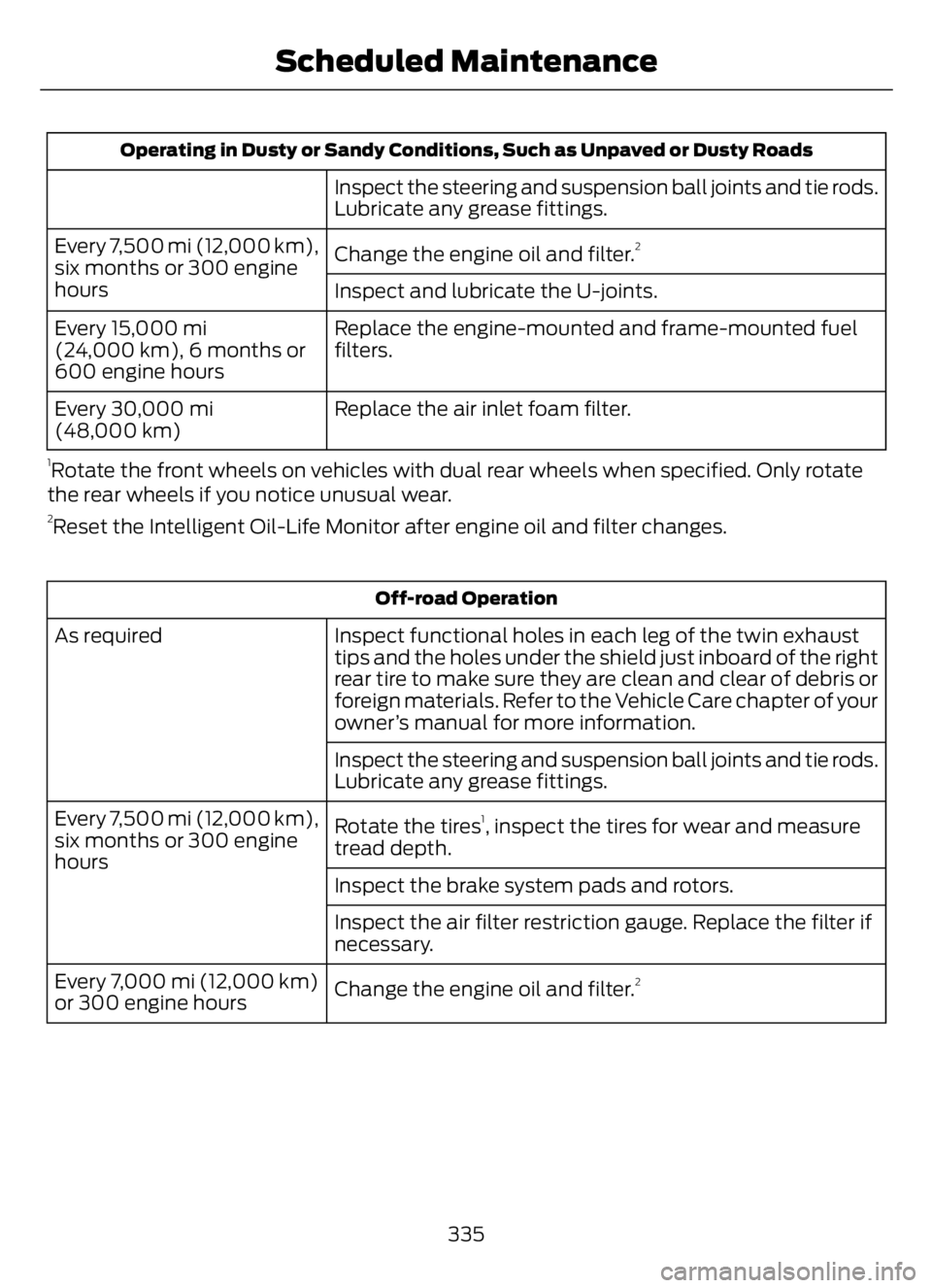2023 FORD F650/750 brake
[x] Cancel search: brakePage 326 of 378

Check Every Month
Tires (including spare) for wear and proper pressure.
Windshield washer fluid level.
1Diesel engine only.
Check Every Six Months
Battery connections. Clean if necessary.
Body and door drain holes for obstructions. Clean if necessary.
Cooling system fluid level and coolant concentration (freeze-point protection).
Door weatherstrips for wear. Lubricate if necessary.
Hinges, latches and outside locks for proper operation. Lubricate if necessary.
Parking brake for proper operation.
Safety belts and seat latches for wear and function.
Safety warning lamps (brake, ABS, airbag and safety belt) for operation.
Washer spray and wiper operation. Clean or replace blades as necessary.
Tightening Lug Nuts
Tighten the lug nuts to the specified torque1 at 500 mi
(800 km) after any wheel disturbance (such as tire rota-
tion, changing a flat tire or wheel removal). Single rear wheels
Tighten the wheel lug nuts to the specified torque
1 at
100 mi (160 km), and again at 500 mi (800 km) of new
vehicle operation and after any wheel disturbance (such
as tire rotation, changing a flat tire or wheel removal). Dual rear wheels
1 See Technical Specifications (page 286).
322
Scheduled Maintenance
Page 327 of 378

Multi-point Inspection
In order to keep your vehicle running right,
it is important to have the systems on your
vehicle checked regularly. This can help
identify potential issues and prevent majorproblems. We recommend having the
following multi-point inspection performed
at every scheduled maintenance interval
to help make sure your vehicle keeps
running great.
Multi-point Inspection
Horn operation Accessory drive belt(s)
Radiator, cooler, heater and A/C hoses Battery performance
Suspension component for leaks or
damage Engine air filter
Steering and linkage Exhaust system
Tires (including spare) for wear and proper
pressure
2Exterior lamps operation
Windshield for cracks, chips or pits
Fluid levels
1; fill if necessary
Washer spray and wiper operation For oil and fluid leaks
Hazard warning system operation Hood rest for lubrication
1Brake, coolant recovery reservoir, automatic transmission, power steering and window
washer.
2If your vehicle is equipped with a temporary mobility kit, check the tire sealant expiration
Use By date on the canister. Replace as needed.
Be sure to ask your dealership service
advisor or technician about the multi-point
vehicle inspection. It is a comprehensive
way to perform a thorough inspection of
your vehicle. Your checklist gives you
immediate feedback on the overall
condition of your vehicle.
NORMAL SCHEDULED
MAINTENANCE
Intelligent Oil-Life Monitor™ -
Diesel Engine Only
Your diesel engine has an Intelligent
Oil-Life Monitor that determines when you
should change the engine oil based on how
you use your vehicle. By using several
important factors in its calculations, the
monitor helps reduce the cost of owning
your vehicle and reduces environmental
waste at the same time.
323
Scheduled Maintenance
Page 329 of 378

Gasoline Engines
7,500 mi (12,000 km) or Six Months Whichever Comes First
Rotate the tires, inspect tire wear and measure the tread depth.1
Inspect the wheels and related components for abnormal noise, wear, looseness or
drag.
Perform a multi-point inspection, recommended.
Inspect front oil hubs for leaks and check fluid level through hub cap sight glass.
1 Rotate the front wheels on vehicles with dual rear wheels when specified. Only rotate
the rear wheels if you notice unusual wear.
10,000 mi (16,000 km) /450 Engine Hours or 12 Months Whichever Comes First
Change the engine oil and filter.
15,000 mi (24,000 km) or 12 Months Whichever Comes First
Inspect the automatic transmission fluid level. Consult an authorized dealer for
requirements.
Inspect the brake pads, shoes, rotors, drums, brake linings, hoses and the parking brake.
Inspect the engine cooling system concentration, freeze-point protection, level and
hoses.
Inspect the exhaust system and heat shields.
Inspect the steering linkage, ball joints, suspension, tie-rod ends, driveshaft and the U-
joints. Lubricate any components that have grease fittings.
Brake Fluid Maintenance1
Change the brake fluid.2Every 3 Years
1 Perform this maintenance item every 3 years. Do not exceed the designated time for
the interval.
2 Brake fluid servicing requires special equipment available at your authorized dealer.
325
Scheduled Maintenance
Page 331 of 378

At Every Oil Change Interval as Indicated by the Information Display1
Perform a multi-point inspection, recommended.
Inspect the air filter restriction gauge. Replace the filter if necessary.
Inspect the automatic transmission fluid level. Consult an authorized dealer for
requirements.
Inspect the brake pads, shoes, rotors, drums, brake linings, hoses and the parking brake.
Inspect the engine and secondary coolant concentration, freeze-point protection, level
and hoses.
Inspect the exhaust system and heat shields.
Inspect the steering linkage, ball joints, suspension, tie-rod ends, driveshaft and the U-
joints. Lubricate any components that have grease fittings.
Inspect front oil hubs for leaks and check fluid level through hub cap sight glass.
1 Do not exceed one year/10,000 mi (16,000 km) or 350 engine hours between service
intervals.
2 Reset the Intelligent Oil-Life Monitor after engine oil and filter changes. See Oil Change
Indicator Reset (page 227).
3 Rotate the front wheels on vehicles with dual rear wheels when specified. Only rotate
the rear wheels if you notice unusual wear.
Brake Fluid Maintenance1
Change the brake fluid.2Every 3 Years
1 Perform this maintenance item every 3 years. Do not exceed the designated time for
the interval.
2 Brake fluid servicing requires special equipment available at your authorized dealer.
Other Maintenance Items1
Replace the engine-mounted and frame-mounted fuel
filters.2Every 22,000 mi
(36,000 km)
Inspect the engine and secondary cooling system coolant
concentration, freeze-point protection, additive, corrosion
inhibitor, strength, coolant level, and hoses. Add coolant
additive if necessary.
3
Every 30,000 mi
(48,000 km)
327
Scheduled Maintenance
Page 333 of 378

SPECIAL OPERATING
CONDITIONS SCHEDULED
MAINTENANCE
Gasoline Engines
If you operate your vehicle primarily in anyof the following conditions, you need to
perform extra maintenance as indicated.
If you operate your vehicle occasionally
under any of these conditions, it is not
necessary to perform the extra
maintenance. For specific
recommendations, see your dealership
service advisor or technician.
Towing a Trailer
Inspect and lubricate the U-joints. Inspect frequently, service
as required
See axle maintenance items under Exceptions.
Inspect the wheels and related components for abnormal
noise, wear, looseness or drag. Every 5,000 mi (8,000 km)
Change the engine oil and filter. Every 5,000 mi (8,000 km)
or six months
Inspect and lubricate U-joints.
Rotate the tires
1and inspect them for wear, and measure
the tread depth. Every 7,500 mi (12,000 km)
Replace the spark plugs. Every 60,000 mi
(96,000 km)
Replace the spark plug wires.
1Rotate the front wheels on vehicles with dual rear wheels when specified. Only rotate
the rear wheels if you notice unusual wear.
Extensive Idling or Low-speed Driving for Long Distances, as in Heavy Commercial Use
(Such as Delivery, Taxi, Patrol Car or Livery)
Replace engine air filter. Inspect frequently, service
as required
Inspect the brake system. Every 5,000 mi (8,000 km)
Inspect the wheels and related components for abnormal
noise, wear, looseness or drag.
Lubricate the control arm and steering ball joints if
equipped with grease fittings.
Inspect and lubricate U-joints. Every 5,000 mi (8,000 km)
or six months
329
Scheduled Maintenance
Page 338 of 378

Sustained High-speed Driving at Gross Vehicle Weight Rating, Maximum Loaded Weight
for Vehicle Operation
Change the engine oil and filter as indicated by the
information display, and perform the services listed in the
scheduled maintenance chart. As required
Replace the engine-mounted and frame-mounted fuel
filters. Every 15,000 mi
(24,000 km), six months or
600 engine hours
Inspect the coolant concentration, freeze-point protection
and additive, corrosion inhibitor strength. Add coolant
additive if necessary. Every 30,000 mi
(48,000 km) or 1200 engine
hours
Flush and refill the coolant. Do not add coolant additive. Every 60,000 mi
(96,000 km) or 2400
engine hours
Note:When adding coolant additive, do not exceed the specified maximum of 47 fl oz
(1.4 L) for the engine and 20 fl oz (473 ml) for the secondary cooling system. Operating the
engine with excessive coolant additive may cause overheating which could lead to severe,
permanent engine damage.
Note:After the initial coolant flush and fill at 60,000 mi (96,000 km) or 2400 engine
hours, flush and fill every 45,000 mi (72,000 km) or 1800 engine hours thereafter.
Operating in Sustained Ambient Temperatures Below -9.4°F (-23°C) or Above 100.3°F
(38°C)
Change the engine oil and filter as indicated by the
information display, and perform the services listed in the
scheduled maintenance chart. As required
Replace the engine-mounted and frame-mounted fuel
filters. Every 15,000 mi
(24,000 km), six months or
600 engine hours
Operating in Dusty or Sandy Conditions, Such as Unpaved or Dusty Roads
Rotate the tires1, inspect the tires for wear and measure
tread depth. Every 7,500 mi (12,000 km)
Inspect the brake system pads and rotors.
Inspect the air filter restriction gauge. Replace the filter if
necessary.
334
Scheduled Maintenance
Page 339 of 378

Operating in Dusty or Sandy Conditions, Such as Unpaved or Dusty Roads
Inspect the steering and suspension ball joints and tie rods.
Lubricate any grease fittings.
Change the engine oil and filter.
2Every 7,500 mi (12,000 km),
six months or 300 engine
hours
Inspect and lubricate the U-joints.
Replace the engine-mounted and frame-mounted fuel
filters. Every 15,000 mi
(24,000 km), 6 months or
600 engine hours
Replace the air inlet foam filter. Every 30,000 mi
(48,000 km)
1Rotate the front wheels on vehicles with dual rear wheels when specified. Only rotate
the rear wheels if you notice unusual wear.
2Reset the Intelligent Oil-Life Monitor after engine oil and filter changes.
Off-road Operation
Inspect functional holes in each leg of the twin exhaust
tips and the holes under the shield just inboard of the right
rear tire to make sure they are clean and clear of debris or
foreign materials. Refer to the Vehicle Care chapter of your
owner’s manual for more information. As required
Inspect the steering and suspension ball joints and tie rods.
Lubricate any grease fittings.
Rotate the tires
1, inspect the tires for wear and measure
tread depth. Every 7,500 mi (12,000 km),
six months or 300 engine
hours
Inspect the brake system pads and rotors.
Inspect the air filter restriction gauge. Replace the filter if
necessary.
Change the engine oil and filter.
2Every 7,000 mi (12,000 km)
or 300 engine hours
335
Scheduled Maintenance
Page 347 of 378

ELECTROMAGNETIC
COMPATIBILITY
WARNING: Do not place objects
or mount equipment on or near the
airbag cover, on the side of the front or
rear seatbacks, or in areas that may
come into contact with a deploying
airbag. Failure to follow these
instructions may increase the risk of
personal injury in the event of a crash.
WARNING: Do not fasten antenna
cables to vehicle wiring, fuel pipes and
brake pipes.
WARNING: Keep antenna and
power cables at least 4 in (10 cm) from
any electronic modules and airbags.Note:We test and certify your vehicle to
meet electromagnetic compatibility
legislation. It is your responsibility to make
sure that any equipment an authorized
dealer installs on your vehicle complies with
applicable local legislation and other
requirements. Installation of some
aftermarket electronic devices could
degrade the performance of vehicle
functions, which use radio frequency signals
such as broadcast radio receiver, tire
pressure monitoring system, push button
start,Bluetooth® connectivity or satellite
navigation.
Note:Any radio frequency transmitter
equipment in your vehicle (such as cellular
telephones and amateur radio transmitters)
must keep to the parameters in the
following illustrations and table. We do not
provide any other special provisions or
conditions for installations or use.
Car/SUV
E239120
343
Appendices